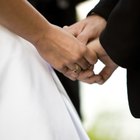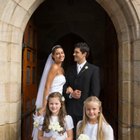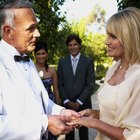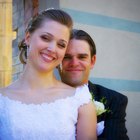
The are several ways in which a wedding officiant may word a ceremony. Some couples prefer to get married in a way that's scripted according to tradition and custom. Others, however, favor a more contemporary approach, phrased in a manner that holds personal meaning for each individual. No matter which way a marriage ceremony is conducted, most share a somewhat standard wording and format.
Opening
At the start of most weddings, the officiant will generally welcome all in attendance. He will then announce the reason for which they have been brought together. For example, a customary opening to a wedding could be spoken as "Welcome to all gathered in attendance today. We are here to witness the union of Mark Johnson and Sharon Miller in holy matrimony."
Reading
The reading portion of a wedding ceremony is typically a short statement made to both the bride and groom. The celebrant will take this time to explain the value of marriage and advise the couple, while highlighting the sanctity of their commitment.
A typical reading may go as follows: "Mark and Sharon, today you pledge your love before family and friends. You choose, from this day forward, to travel together on a lifelong journey as husband and wife. Allow the love that brought you here today to serve as your guide along this path. Love fosters kindness, patience and wisdom. Keep these things for each other always and you will build a home upon stable ground, able to withstand even the worst of storms."
Vows
After the reading, both the bride and groom will be asked to declare their vows, promises of love and commitment to one another. The vows are typically given in one of two ways. The officiant may say the vows one phrase at a time and ask both parties, in turn, to repeat his words. Alternatively, the officiant may simply pose the entire set of vows as a question to both bride and groom, asking only for each person to say "I do" at the end.
For example, the officiant may say, "Do you, Mark, take Sharon to be your lawfully wedded wife, to love and to hold, through sickness and health, 'til death do you part?"
The Rings
In a typically wedding ceremony, the bride and groom are asked to exchange rings. The celebrant often encourages each party to make a simple statement of commitment while placing the ring on the other's finger. A common exchange ritual, for instance, is for both the bride and groom to announce "With this ring, I thee wed" during the hand-off.
Declaration
The declaration is the part of a wedding when the couple are officially announced as husband and wife. The celebrant will often say something in the order of, "By the power vested in me by the state of New Jersey, I now pronounce you husband and wife." In a traditional ceremony, the officiant will then turn to the husband and say, "You may kiss you bride." It is then customary that the couple faces the crowd as the officiant proclaims, "Ladies and gentlemen, I present to you Mr. and Mrs. Mark Johnson." However, a more modern approach is to say, "I present to you Mark and Sharon Johnson."
Related Articles

What is Said During a Justice of the ...

What a Minister Says at a Wedding

Christian Wedding Prayers and Blessings

Mandatory Legal Phrases for Wedding Vows

Does the Wedding or Engagement Ring go ...

Wedding Prayers for a Bridal Brunch

Wedding Prayers of the Faithful

How to Have a Covenant Marriage Ceremony

Wedding Ceremony Sequence of Events

How to Plan a Single Ring Wedding ...

How to Write a Commitment Ceremony

Etiquette for Late Wedding Presents

How to Officiate a Wedding Renewal

Commitment Ceremony Vs. Wedding Ceremony

Why Does the Wedding Ring Go on the 4th ...

How to Get Certified to Marry Couples

Prayers for an Estranged Son

How to Celebrate a 15-Year Anniversary

How to Address an Invitation to a Pastor

Wedding Prayers & Toasts
References
Writer Bio
Harold Sconiers is a jack of many trades. As an adolescent, he achieved accolades as an amateur boxer, subsequently taking his skills into the professional ranks. At the same time, his naturally creative mind allowed him to delve into developing other aspects of his artistic side. He is a community actor, writer, amateur filmmaker and inventor.
Photo Credits
Comstock Images/Comstock/Getty Images